Related Research Articles

Earl of Chichester is a title that has been created three times, twice in the Peerage of England and once in the Peerage of the United Kingdom. The current title was created in the Peerage of the United Kingdom in 1801 for Thomas Pelham, 2nd Baron Pelham of Stanmer.

Earl of Iddesleigh, in the County of Devon, is a title in the Peerage of the United Kingdom. It was created in 1885 for the Conservative politician Sir Stafford Northcote, 8th Baronet, of Pynes in the parish of Upton Pyne near Exeter in Devon and lord of the manor of Iddesleigh, 28 miles north-west of Pynes. He served as President of the Board of Trade, Secretary of State for India, Chancellor of the Exchequer, First Lord of the Treasury and Foreign Secretary and was Joint Leader of the Conservative Party from 1881 to 1885. Northcote was made Viscount St Cyres, of Newton Saint Cyres in the County of Devon, at the same time he was given the earldom. This title is also in the Peerage of the United Kingdom.

Earl of Stradbroke, in the County of Suffolk, is a title in the Peerage of the United Kingdom. It was created in 1821 for John Rous, 1st Baron Rous, who had earlier represented Suffolk in the House of Commons.
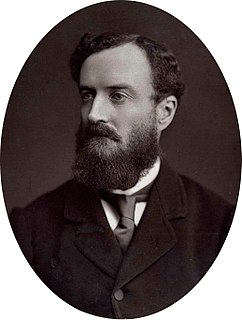
Earl St Aldwyn, of Coln St Aldwyn in the County of Gloucester, is a title in the Peerage of the United Kingdom. It was created in 1915 for the prominent Conservative politician Michael Hicks Beach, 1st Viscount St Aldwyn, known from 1854 to 1907 as Sir Michael Hicks Beach, 9th Baronet, of Beverston. He was Chancellor of the Exchequer from 1885 to 1886 and again from 1895 to 1902. Hicks Beach had already been created Viscount St Aldwyn, of Coln St Aldwyn in the County of Gloucester, in 1906, and was made Viscount Quenington, of Quenington in the County of Gloucester, at the same time he was given the earldom. Both titles are in the Peerage of the United Kingdom. He was succeeded by his grandson, the second Earl, the son of Michael Hicks Beach, Viscount Quenington, Member of Parliament for Tewkesbury, who was killed in action in 1916. Lord St Aldwyn was also a Conservative politician and was Captain of the Honourable Corps of Gentlemen-at-Arms between 1958 and 1964 and 1970 and 1974. As of 2018 the titles are held by his eldest son, the third Earl, who succeeded in 1992.

Baron Hesketh, of Hesketh in the County Palatine of Lancaster, is a title in the Peerage of the United Kingdom. It was created in 1935 for Sir Thomas Fermor-Hesketh, 8th Baronet, who had previously briefly represented Enfield in the House of Commons as a Conservative. As of 2010 the titles are held by his grandson, the third Baron, who succeeded his father in 1955. Lord Hesketh held junior ministerial positions in the Conservative administrations of Margaret Thatcher and John Major. However, he lost his seat in the House of Lords after the House of Lords Act 1999 removed the automatic right of hereditary peers to sit in the upper chamber of Parliament.

Baron Glenconner, of The Glen in the County of Peebles, is a title in the Peerage of the United Kingdom. It was created in 1911 for Sir Edward Tennant, 2nd Baronet, who had earlier represented Salisbury in the House of Commons as a Liberal and also served as Lord Lieutenant of Peeblesshire. Lord Glenconner was succeeded by his second son, the second baron. The latter was succeeded in 1983 by his eldest son, the third baron, who bought the island of Mustique. As of 2014, the titles are held by the third baron's grandson, the fourth baron, who became the next-to-youngest peer in the realm when he succeeded in August 2010.

Baron Nelson of Stafford, of Hilcote Hall in the County of Stafford, is a title in the Peerage of the United Kingdom. It was created in 1960 for the businessman Sir George Nelson, 1st Baronet, who for many years was Chairman of English Electric. He had already been created a Baronet in the Baronetage of the United Kingdom in 1955. He was succeeded by his only son, the second Baron. He was also Chairman of English Electric as well as a director of the Bank of England. As of 2022, the titles are held by his grandson, the fourth Baron, who succeeded his father in 2006.
Baron Leighton of St Mellons, of St Mellons in the County of Monmouth, is a title in the Peerage of the United Kingdom. It was created on 25 January 1962 for the Welsh shipping magnate Sir Leighton Seager, 1st Baronet. He was the son of Sir William Henry Seager. Seager had already been created a Baronet, of St Mellons in the County of Monmouth on 1 July 1952. As of 2017 the titles are held by his grandson, the third Baron, who succeeded his father in 1998. As of 31 December 2016 the present Baronet has not successfully proven his succession and is therefore not on the Official Roll of the Baronetage, with the baronetcy considered dormant since 1998.

There have been two baronetcies created for persons with the surname Arthur, both in the Baronetage of the United Kingdom. As of 2014 both creations are extant.
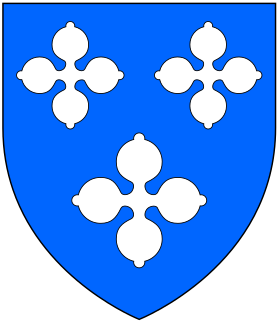
Viscount D'Abernon, of Esher and of Stoke d'Abernon in the County of Surrey, was a title in the Peerage of the United Kingdom. It was created on 20 February 1926 for the politician, diplomat and writer Edgar Vincent, 1st Baron D'Abernon who had been created Baron D'Abernon, of Esher in the County of Surrey, on 2 July 1914. In 1936 he succeeded his elder brother as sixteenth Baronet, of Stoke d'Abernon. All three titles became extinct on his death in 1941.
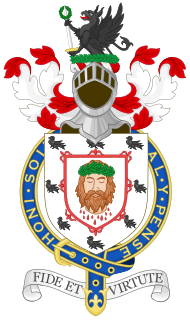
The Gladstone Baronetcy, of Fasque and Balfour in the County of Kincardine, is a title in the Baronetage of the United Kingdom. It was created on 18 July 1846 for the Scottish businessman and politician John Gladstone, father of four-time prime minister William Ewart Gladstone. Born John Gladstones, the son of the merchant Thomas Gladstones, John assumed by royal licence the surname of Gladstone in 1835. The name Gladstone is geographical, deriving from a farmstead near Biggar in Lanarkshire; it comes from the Old English for "kestrel stone".
There have been six baronetcies created for persons with the surname Brooke, one in the Baronetage of England, one in the Baronetage of Ireland and four in the Baronetage of the United Kingdom. As of 2015 four of the creations are extant, though one has been subsumed into a peerage.
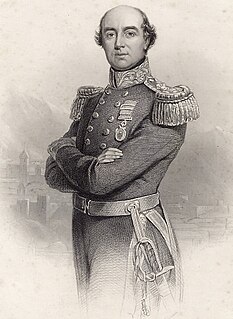
There have been twenty one baronetcies created for persons with the surname Williams, eight in the Baronetage of England, three in the Baronetage of Great Britain and ten in the Baronetage of the United Kingdom. Only six of the creations are extant as of 2017.

There have been four baronetcies created for persons with the surname Miller, two in the Baronetage of England, one in the Baronetage of Great Britain and one in the Baronetage of the United Kingdom. Two of the creations are extant as of 2008.
There have been nine baronetcies created for persons with the surname Moore, two in the Baronetage of England, one in the Baronetage of Ireland, two in the Baronetage of Great Britain and four in the Baronetage of the United Kingdom. As of 2014 two creations are extant and one considered dormant.

There have been seventeen baronetcies for persons with the surname Stewart, ten in the Baronetage of Nova Scotia, one in the Baronetage of Ireland and six in the Baronetage of the United Kingdom. See also Steuart baronets, Henderson-Stewart baronets, MacTaggart-Stewart baronets and Stewart-Clark baronets.

The Gibson, later Gibson-Carmichael, later Gibson-Craig-Carmichael Baronetcy, of Keirhill in the County of Edinburgh, is a title in the Baronetage of Nova Scotia. It was created on 31 December 1702 for Thomas Gibson, with remainder to his heirs male. The sixth Baronet assumed the additional surname of Carmichael. The eleventh Baronet was a Liberal politician. In 1912, he created Baron Carmichael, of Skirling in the County of Peebles, in the Peerage of the United Kingdom. The barony died in 1926, while he was succeeded in the baronetcy by his kinsman Sir Henry Thomas Gibson-Craig-Carmichael, 5th Baronet, of Riccarton, who became the twelfth Baronet of Keirhill and assumed the additional surname of Carmichael.
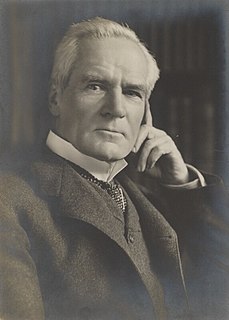
Sir Henry Craik, 1st Baronet, was a Scottish Unionist politician.

The Wombwell Baronetcy, of Wombwell in the County of York, is a title in the Baronetage of Great Britain. It was created on 26 August 1778 for George Wombwell, Chairman of the Honourable East India Company and Member of Parliament for Huntingdon. The fourth Baronet fought in the Crimean War and took part in the Charge of the Light Brigade and in 1861 served as High Sheriff of Yorkshire. As of 13 June 2007 the presumed seventh and present Baronet had not successfully proven his succession to the title, and is therefore not on the Official Roll of the Baronetage, with the baronetcy considered dormant since 1977.

The St John, later St John-Mildmay Baronetcy, of Farley in the County of Southampton, is a title in the Baronetage of Great Britain. It was created on 9 October 1772 for Paulet St John, Member of Parliament for Winchester and Hampshire. The second Baronet represented Hampshire in the House of Commons. The third Baronet was Member of Parliament for Westbury, Winchester and Hampshire. He married Jane, daughter of Carew Mildmay, and assumed the additional surname of Mildmay. The fourth Baronet sat as Member of Parliament for Winchester. The title became dormant in 1955 on the death of the tenth Baronet. In 1998 Walter John Hugh St John-Mildmay successfully proved his right to the title and became the eleventh Baronet.
References
- ↑ "No. 33131". The London Gazette . 9 February 1926. p. 982.
- ↑ Burke's Peerage. 1949.